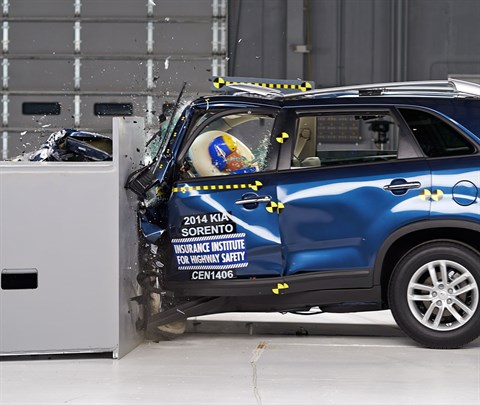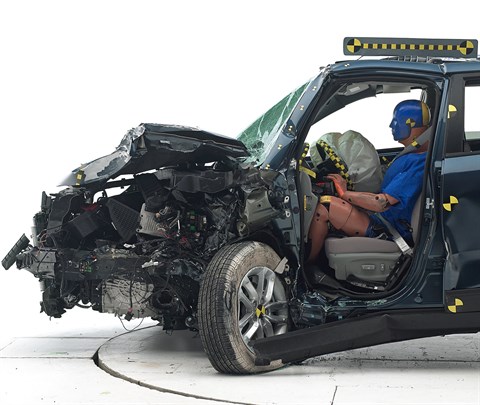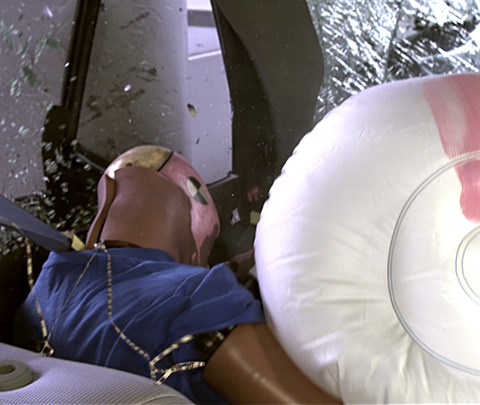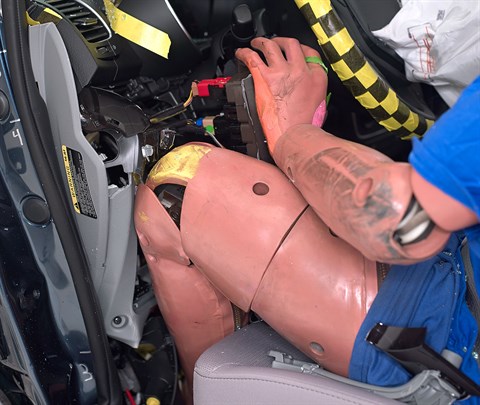Small overlap front: driver-side
Rating applies to 2014-15 models
Tested vehicle: 2014 Kia Sorento LX 4-door 4wd
The Kia Sorento was re-engineered for the 2014 model year.
| Overall evaluation | |
|---|---|
| Structure and safety cage | |
| Driver injury measures | |
| Head/neck | |
| Chest | |
| Hip/thigh | |
| Lower leg/foot | |
| Driver restraints and dummy kinematics The dummy’s head barely contacted the frontal airbag before sliding off the left side as the steering column moved 13 cm to the right. The side curtain airbag did not deploy, leaving the dummy's head vulnerable to contacts with side structure and outside objects. |

Action shot taken during the small overlap frontal crash test.

The dummy's position in relation to the door frame, steering wheel, and instrument panel after the crash test indicates that the driver's survival space was not maintained well.

The dummy’s head barely contacted the frontal airbag before sliding off the left side as the steering column moved to the right. The side curtain airbag did not deploy.

Door hinge pillar and instrument panel intrusion was extensive and contributed to a high risk of injury the left lower leg and a moderate risk to the left thigh and knee.
Measures of occupant compartment intrusion on driver side
| Test ID | CEN1406 |
|---|---|
| Lower occupant compartment | |
| Lower hinge pillar max (cm) | 27 |
| Footrest (cm) | 19 |
| Left toepan (cm) | 10 |
| Brake pedal (cm) | 6 |
| Parking brake (cm) | 28 |
| Rocker panel lateral average (cm) | 15 |
| Upper occupant compartment | |
| Steering column | 7 |
| Upper hinge pillar max (cm) | 21 |
| Upper dash (cm) | 18 |
| Lower instrument panel (cm) | 18 |
Driver injury measures
| Test ID | CEN1406 |
|---|---|
| Head | |
| HIC-15 | 179 |
| Peak gs at hard contact | no contact |
| Neck | |
| Tension (kN) | 1.5 |
| Extension bending moment (Nm) | 11 |
| Maximum Nij | 0.30 |
| Chest maximum compression (mm) | 18 |
| Femur (kN) | |
| Left | 7.5 |
| Right | 1.2 |
| Knee displacement (mm) | |
| Left | 17 |
| Right | 4 |
| Knee-thigh-hip injury risk (%) | |
| Left | 14 |
| Right | 0 |
| Maximum tibia index | |
| Left | 1.51 |
| Right | 0.47 |
| Tibia axial force (kN) | |
| Left | 3.0 |
| Right | 1.0 |
| Foot acceleration (g) | |
| Left | 120 |
| Right | 51 |
Moderate overlap front: original test
Rating applies to 2014-15 models
Tested vehicle: 2014 Kia Sorento EX 4-door 4wd
The Kia Sorento was re-engineered for the 2014 model year. Moderate overlap frontal ratings are assigned by the Institute based on a test conducted by Hyundai/Kia as part of frontal crash test verification.
| Overall evaluation | |
|---|---|
| Structure and safety cage | |
| Driver injury measures | |
| Head/neck | |
| Chest | |
| Leg/foot, left | |
| Leg/foot, right | |
| Driver restraints and dummy kinematics |
Measures of occupant compartment intrusion on driver side
| Test ID | VTF1224 |
|---|---|
| Footwell intrusion | |
| Footrest (cm) | 6 |
| Left (cm) | 10 |
| Center (cm) | 8 |
| Right (cm) | 5 |
| Brake pedal (cm) | 6 |
| Instrument panel rearward movement | |
| Left (cm) | 1 |
| Right (cm) | 1 |
| Steering column movement | |
| Upward (cm) | 2 |
| Rearward (cm) | 1 |
| A-pillar rearward movement (cm) | 1 |
Driver injury measures
| Test ID | VTF1224 |
|---|---|
| Head | |
| HIC-15 | 218 |
| Peak gs at hard contact | no contact |
| Neck | |
| Tension (kN) | 1.2 |
| Extension bending moment (Nm) | 17 |
| Maximum Nij | 0.23 |
| Chest maximum compression (mm) | 14 |
| Legs | |
| Femur force - left (kN) | 0.6 |
| Femur force - right (kN) | 2.0 |
| Knee displacement - left (mm) | 0 |
| Knee displacement - right (mm) | 6 |
| Maximum tibia index - left | 0.40 |
| Maximum tibia index - right | 0.54 |
| Tibia axial force - left (kN) | 1.7 |
| Tibia axial force - right (kN) | 1.6 |
| Foot acceleration (g) | |
| Left | 64 |
| Right | 91 |
Side: original test
Rating applies to 2014-15 models
Tested vehicle: 2014 Kia Sorento EX 4-door 4wd with standard front and second row head curtain airbags and standard front seat-mounted torso airbags
The Kia Sorento was re-engineered for the 2014 model year. Side ratings are assigned by the Institute based on a test conducted by Hyundai/Kia as part of side crash test verification.
| Overall evaluation | |
|---|---|
| Structure and safety cage | |
| Driver injury measures | |
| Head/neck | |
| Torso | |
| Pelvis/leg | |
| Driver head protection | |
| Rear passenger injury measures | |
| Head/neck | |
| Torso | |
| Pelvis/leg | |
| Rear passenger head protection | |
Measures of occupant compartment intrusion on driver side
| Test ID | VTS1229 |
|---|---|
| B-pillar to longitudinal centerline of driver's seat (cm) | -13.5 |
| Negative numbers indicate the amount by which the crush stopped short of the seat centerline. | |
Driver injury measures
| Test ID | VTS1229 |
|---|---|
| Head HIC-15 | 199 |
| Neck | |
| Tension (kN) | 1.1 |
| Compression (kN) | 0.1 |
| Shoulder | |
| Lateral deflection (mm) | 30 |
| Lateral force (kN) | 1.6 |
| Torso | |
| Maximum deflection (mm) | 24 |
| Average deflection (mm) | 23 |
| Maximum deflection rate (m/s) | 4.40 |
| Maximum viscous criterion (m/s) | 0.40 |
| Pelvis | |
| Iliac force (kN) | 1.8 |
| Acetabulum force (kN) | 2.4 |
| Combined force (kN) | 4.1 |
| Left femur | |
| L-M force (kN) | 0.6 |
| L-M moment (Nm) | 98 |
| A-P moment (Nm) | 25 |
Passenger injury measures
| Test ID | VTS1229 |
|---|---|
| Head HIC-15 | 156 |
| Neck | |
| Tension (kN) | 0.3 |
| Compression (kN) | 0.4 |
| Shoulder | |
| Lateral deflection (mm) | 22 |
| Lateral force (kN) | 1.2 |
| Torso | |
| Maximum deflection (mm) | 27 |
| Average deflection (mm) | 22 |
| Maximum deflection rate (m/s) | 3.50 |
| Maximum viscous criterion (m/s) | 0.40 |
| Pelvis | |
| Iliac force (kN) | 0.6 |
| Acetabulum force (kN) | 1.7 |
| Combined force (kN) | 1.8 |
| Left femur | |
| L-M force (kN) | 1.4 |
| L-M moment (Nm) | 123 |
| A-P moment (Nm) | 20 |
Roof strength
Rating applies to 2011-15 models
Tested vehicle: 2011 Kia Sorento EX 4-door 4wd
Re-engineering of the vehicle for 2014-15 did not affect roof strength. Therefore, rating applies to the 2011-15 models.
| Overall evaluation | |
|---|---|
| Curb weight | 4,048 lbs |
| Peak force | 17,455 lbs |
| Strength-to-weight ratio | 4.31 |
Head restraints & seats
Seat type: Manual cloth seat (AHR)
| Overall evaluation | |
|---|---|
| Dynamic rating | |
| Seat/head restraint geometry |
| Seat type | Manual cloth seat (AHR) |
|---|---|
| Geometry | |
| Backset (mm) | 51 |
| Distance below top of head (mm) | -8 |
| Seat design parameters | |
| Pass/fail | Pass |
| Max T1 acceleration (g) | 9.6 |
| Head contact time (ms) | 66 |
| Force rating | 1 |
| Neck forces | |
| Max neck shear force (N) | 53 |
| Max neck tension (N) | 488 |
How the head restraint & seat test is conducted
Currently, IIHS tests apply only to front seats.
Child seat anchors
Rating applies to 2015 models
| Overall evaluation |
|
| Vehicle trim | LX |
| Seat type | cloth |
This vehicle has 2 rear seating positions with complete child seat attachment (LATCH) hardware.
It has 1 additional seating position with a tether anchor only.
| Overall evaluation |
|
| Vehicle trim | LX |
| Seat type | cloth |
| G | Good |
| A | Acceptable |
| M | Marginal |
| P | Poor |
|
|
Seating positions that rely on borrowed lower anchors or have only a tether anchor available are not rated. |
|
thether anchor symbol
|
Tether anchor |
|
lower anchor symbol
|
Lower anchors |
| Lower anchor(s) can be borrowed from adjacent positions(s) | |
|
|
No hardware available |
Details by seating position
| 1 | |
|---|---|
| Tether anchor | |
| easy-to-find location | |
| other hardware could be confused for anchor | |
| Lower anchors | |
| not too deep in seat | |
| not too much force needed to attach | |
| easy to maneuver around anchors | |
| 2 | |
| Tether anchor | |
| easy-to-find location | |
| no other hardware could be confused for anchor | |
| Lower anchors | |
| none available | |
| 3 | |
| Tether anchor | |
| easy-to-find location | |
| other hardware could be confused for anchor | |
| Lower anchors | |
| not too deep in seat | |
| not too much force needed to attach | |
| easy to maneuver around anchors |
Seat position 21
| Lower anchor A | |
|---|---|
| Open access rated | No |
| Depth (cm) | -2-0 |
| Force (lbs) | 17 |
| Clearance angle (degrees) | 67 |
| Lower anchor B | |
| Open access rated | No |
| Depth (cm) | 0-2 |
| Force (lbs) | 16 |
| Clearance angle (degrees) | 64 |
| Tether anchor | |
| Location | Middle seatback |
| Confusing hardware present | Yes |
| Has contrasting label within 3 inches of tether anchor |
No |
Seat position 22
| Lower anchor A | |
|---|---|
| No lower latch for this seat position | |
| Lower anchor B | |
| No lower latch for this seat position | |
| Tether anchor | |
| Location | Middle seatback |
| Confusing hardware present | No |
| Has contrasting label within 3 inches of tether anchor |
No |
Seat position 23
| Lower anchor A | |
|---|---|
| Open access rated | No |
| Depth (cm) | -2-0 |
| Force (lbs) | 20 |
| Clearance angle (degrees) | 61 |
| Lower anchor B | |
| Open access rated | No |
| Depth (cm) | 0-2 |
| Force (lbs) | 14 |
| Clearance angle (degrees) | 62 |
| Tether anchor | |
| Location | Middle seatback |
| Confusing hardware present | Yes |
| Has contrasting label within 3 inches of tether anchor |
No |
